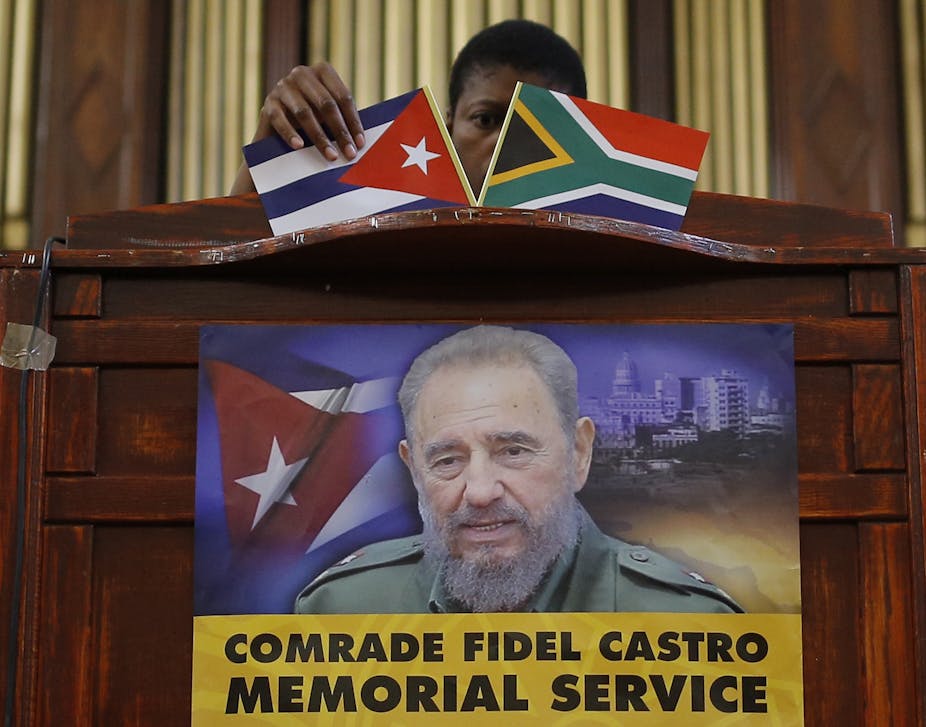Immediately after the death of Fidel Castro, and even before his burial, arguments erupted over whether he was a dictator or a progressive force. All the buried chests of propaganda were exhumed on both sides – their contents used to fuel one-dimensional debate.
Certainly South Africa’s Jacob Zuma was glad to use Castro’s funeral as an excuse to escape the mounting pressure at home. A furious closed-doors debate has been raging within his own party, the ANC, culminating in a failed attempt to oust him as leader.
Fidel’s death was a welcome and fitting distraction. Without the Cuban leader’s very brave foreign policy there would be no majority rule in South Africa today. The ANC would still be exiled in Lusaka and Nelson Mandela would have died in prison. That this was not the case was due to the Cuban interventions in the quarrels of Southern Africa. The ANC did not win military victory. In Angola, the Cubans did.
Most African countries gained independence in the 1960s but, as late as the 1970s, it was not only Rhodesia and South Africa who were resisting Harold Macmillan’s “wind of change”. The Portuguese refused to surrender their colonial rule over Cape Verde, Guinea Bissau, Mozambique and Angola. Armed resistance broke out in all these territories. It took the Portuguese coup d’etat in 1974, led by young officers overthrowing the fascist dictatorship of Salazar, to permit majority rule in the African territories – but it was a contested majority rule in Angola.
The African wars were costing Portugal up to 40% of its budget. Conscripts were coming home in body bags for no obvious gain. Portugal was then the most underdeveloped country in Europe. One of the first things the young officers of what became known as the Carnation Revolution did was to announce independence for the African territories. Angola became independent in November 1975.
But, in Angola, three separate liberation movements contested the right to form the new government. Each had support, in the complex manoeuvres of the Cold War, from different superpowers. When it seemed that the MPLA – the Marxist faction aligned with the Soviet Union – might win power, the West panicked. So did South Africa. The apartheid regime sent in its army, spearheaded by columns of tanks, to prevent a militarised Marxist government from forming. The last thing Pretoria wanted was this kind of inspiration for its own restless masses.
The South Africans were confident they would roll back the MPLA forces. But Fidel Castro, with financing from Moscow, dispatched an army that eventually numbered 25,000 men. The two sides met in one of the great conventional clashes of modern African history.
Reports differ as to how the battles played out, but certainly it seems the Cubans outmanoeuvred the South Africans, who withdrew from Angola. The Cubans stayed.
Throughout Southern Africa, the news of the Cuban “victory” was met with jubilation. At last there was evidence that the mighty apartheid juggernaut could be met in open field and stopped in its tracks. The morale boost to liberation movements in other countries was incalculable.

In the wake of the Portuguese withdrawal from Angola and Mozambique, efforts intensified to find a diplomatic solution to the crisis in Rhodesia. The guerrilla armies there were intensifying their efforts and beginning to deny ground to the white government’s forces. In the end, a combination of military attrition and diplomacy allowed independence for Zimbabwe and the advent of Robert Mugabe in 1980.
The response of South Africa was to devise a military doctrine called Total Strategy, in which different forms of pressure were to be applied to each country in the region. Against Angola, it was to be support for a dissident guerrilla group led by Jonas Savimbi; capture of the south of the country as a buffer zone for South Africa and its own “colony” of South West Africa (now Namibia); and conventional war led by armoured tank columns.
The region, and Angola within it, took a pounding. In 1987, thinking the moment was ripe, the South Africans thought they could secure all of southern Angola as a client state under Savimbi. The objective was to capture the largest city in the region, Cuito Cuanavale, for Savimbi to use as a capital.
The battle for Cuito Cuanavale lasted well into 1988. Gorbachev sent a squadron of latest-generation aircraft, with Soviet pilots, to bolster the MPLA and Cuban positions. Again, a war of manoeuvre broke out and the South Africans, under huge pressure from the near encirclement of their positions, withdrew.
Lasting legacy
It was an immense Cuban victory. In its wake, the Nationalist apartheid government went through a palace revolution; F.W. de Klerk emerged as its new president; Chester Crocker, the US assistant secretary of state, led a brilliant diplomacy that brought peace to the region and independence to Namibia; de Klerk and Zambia’s President Kenneth Kaunda began talks in 1989 that led to the release of Nelson Mandela in 1990. None of this would have been possible without the Cuban stand.
So, although Fidel has a mixed record at home – one of authoritarian, sometimes brutal rule, tempered by huge cultural investment and immense strides in health care – his African reputation is as a man who changed history.
Without a countervailing military force to the US-supported state-of-the-art South African military machine, the African liberation armies by themselves could not have succeeded. Fidel sent tanks and thousands of soldiers. The Soviets sent warplanes.
It is natural that nations take as much credit as possible for their own liberation. But, at this moment, it might be satisfactory at least to acknowledge a strange man with a beard who had enough troubles of his own at home – a CIA invasion, the risk of nuclear war, sanctions, attempted assassinations, restlessness amongst an economically dispirited population – but who still reached out.

